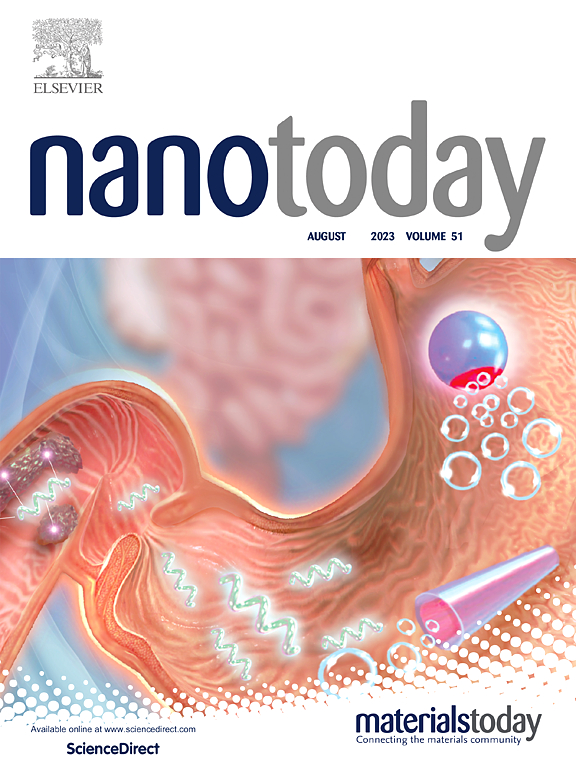Translational selenium nanoparticles enhance NKG2D-mediated cytotoxicity of NK cells against malignant pleural mesothelioma cells through the TrxR1-pSTAT3 pathway
IF 13.2
1区 材料科学
Q1 CHEMISTRY, MULTIDISCIPLINARY
引用次数: 0
Abstract
Malignant pleural mesothelioma (MPM) constitutes a rare classification of malignant tumors that originate within pleural tissue, with epithelioid tumors predominantly comprising its primary pathological subtype. Currently, the combination of pemetrexed and platinum remains the frontline therapeutic strategy for the treatment of MPM. However, recent advancements in the field of immune checkpoint inhibitors have redirected the research spotlight towards the intricate immune microenvironment of MPM. Selenium (Se), a vital trace element, plays pivotal roles in both antitumor and immunoregulation. This study delves into Se nanoparticles (SeNPs) and their functionalized derivatives, specifically lentinan-functionalized SeNPs (LET-SeNPs), with the aim of exploring their potential applications in the treatment of MPM. To tackle the challenge posed by pleural effusion (PE) in malignant pleural mesothelioma (MPM-PE), PE and peripheral blood samples were meticulously collected from MPM patients and subjected to processing utilizing LET-SeNPs. By evaluating the influence of low-energy transfer LET-SeNPs on lymphocytes, we observed an enhanced sensitivity of MPM to natural killer (NK) cells that were pretreated with LET-SeNPs. LET-SeNPs could activate NK92 cells in advance through the TrxR1-pSTAT3 pathway, and further enhance the toxic effect on MPM cells through the interaction of NKG2D-NKG2DL. This process has shown a powerful effect in reducing the invasiveness of MPM and enhancing its penetration and killing efficiency. This finding provides novel therapeutic insights and potential strategies for the treatment of patients with MPM.
翻译硒纳米颗粒通过TrxR1-pSTAT3途径增强nkg2d介导的NK细胞对恶性胸膜间皮瘤细胞的细胞毒性
恶性胸膜间皮瘤(MPM)是一种罕见的恶性肿瘤,起源于胸膜组织,上皮样肿瘤主要包括其主要病理亚型。目前,培美曲塞和铂的联合治疗仍然是治疗MPM的一线治疗策略。然而,免疫检查点抑制剂领域的最新进展使研究焦点转向了MPM复杂的免疫微环境。硒(Se)是一种重要的微量元素,在抗肿瘤和免疫调节中起着关键作用。本研究深入研究硒纳米颗粒(SeNPs)及其功能化衍生物,特别是香菇功能化SeNPs (LET-SeNPs),旨在探索其在MPM治疗中的潜在应用。为了解决恶性胸膜间皮瘤(MPM-PE)患者胸膜积液(PE)带来的挑战,我们精心收集了MPM患者的PE和外周血样本,并使用LET-SeNPs进行处理。通过评估低能量转移LET-SeNPs对淋巴细胞的影响,我们观察到经LET-SeNPs预处理的MPM对自然杀伤(NK)细胞的敏感性增强。LET-SeNPs可以通过TrxR1-pSTAT3通路提前激活NK92细胞,并通过NKG2D-NKG2DL的相互作用进一步增强对MPM细胞的毒性作用。该工艺对降低MPM的侵入性,提高其侵彻和杀伤效率具有重要作用。这一发现为MPM患者的治疗提供了新的治疗见解和潜在的策略。
本文章由计算机程序翻译,如有差异,请以英文原文为准。
求助全文
约1分钟内获得全文
求助全文
来源期刊

Nano Today
工程技术-材料科学:综合
CiteScore
21.50
自引率
3.40%
发文量
305
审稿时长
40 days
期刊介绍:
Nano Today is a journal dedicated to publishing influential and innovative work in the field of nanoscience and technology. It covers a wide range of subject areas including biomaterials, materials chemistry, materials science, chemistry, bioengineering, biochemistry, genetics and molecular biology, engineering, and nanotechnology. The journal considers articles that inform readers about the latest research, breakthroughs, and topical issues in these fields. It provides comprehensive coverage through a mixture of peer-reviewed articles, research news, and information on key developments. Nano Today is abstracted and indexed in Science Citation Index, Ei Compendex, Embase, Scopus, and INSPEC.
 求助内容:
求助内容: 应助结果提醒方式:
应助结果提醒方式:


